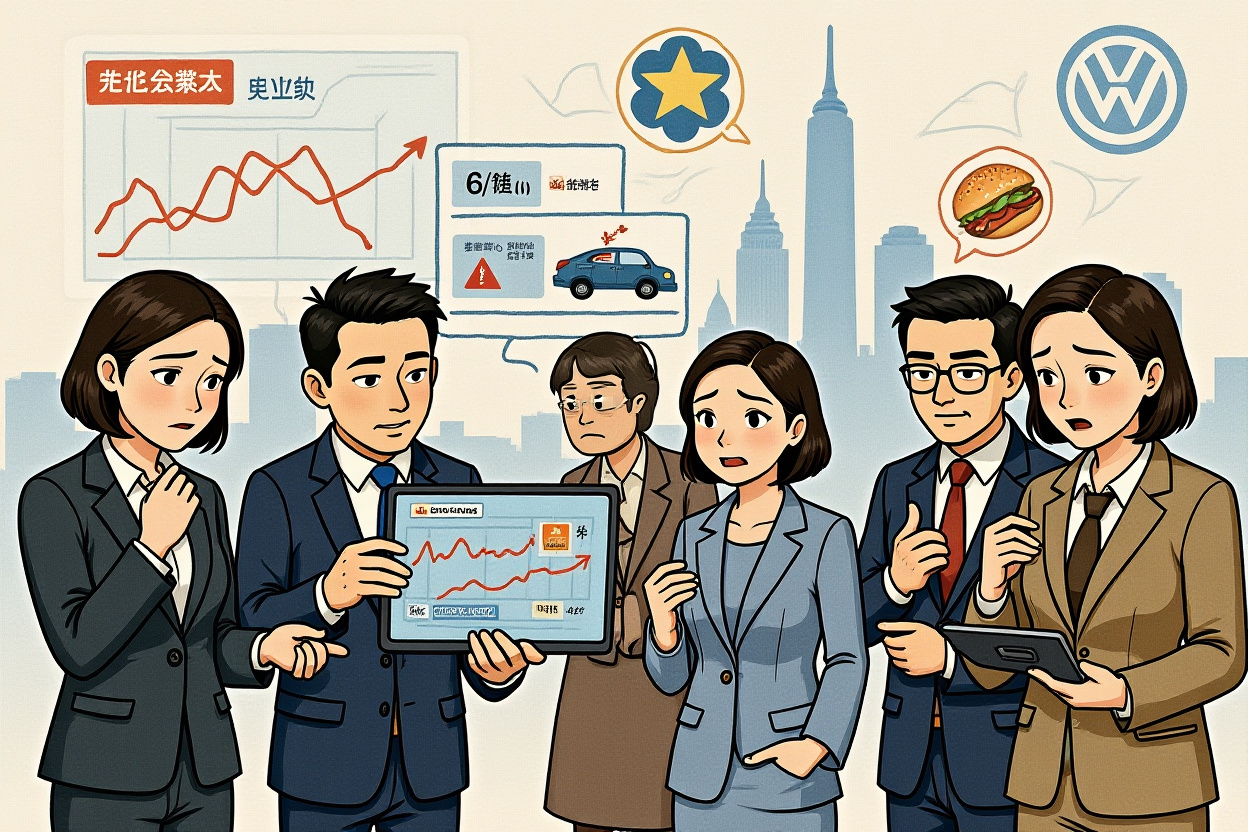The Chattanooga Slowdown: American Dreams Deferred
At Volkswagen’s Chattanooga, Tennessee plant, the production lines tell a silent story of retreat. The German automaker has quietly reduced assembly rates for its ID.4 electric SUV, with 160 employees facing furloughs starting late October. While these workers will receive 80% of their base salary and full benefits, this decision speaks volumes about Volkswagen’s struggling electric ambitions in the American market.
According to reports from Electrek, Volkswagen officially announced production cuts for its pure electric SUV model ID.4 at the Chattanooga factory. This strategic pullback comes directly from the ID.4’s failure to meet sales expectations in the United States, despite early promise as Tesla’s most credible European challenger.
Meanwhile, Volkswagen Group CEO Oliver Blume faces mounting pressure over his dual leadership role heading both Volkswagen and Porsche. Labor representatives have publicly demanded he abandon one of these positions, creating management instability at the worst possible time. From North American production cuts to leadership controversies, the百年大众 (century-old Volkswagen) faces dual pressures of electrification transition and leadership stability.
Subsidy Withdrawal Triggers Sales Avalanche
Positioned as the German answer to Tesla’s Model Y, the ID.4 initially showed promising momentum in the US market. The electric SUV delivered 38,000 units in 2023 only to experience a cliff-like drop to 17,000 units in 2024. The downward spiral intensified in 2025: first-half sales fell 19% year-over-year, with the second quarter witnessing a devastating 65% collapse to fewer than 2,000 units.
The withdrawal of federal subsidies marked a critical turning point in the ID.4’s fortunes. As of January 2025, the ID.4 still held the third position in US electric vehicle sales rankings. But losing eligibility for the $7,500 federal tax credit sent its sales figures into freefall.
An even more severe storm approaches: the “Big and Beautiful” legislation signed by Trump declares that all new energy vehicle subsidies will completely terminate on September 30th. In a desperate survival move, Volkswagen implemented drastic price cuts, reducing ID.4 monthly leases to $129—making it the lowest leasing cost electric vehicle in America—yet still failing to reverse its fortunes.
In an ironic footnote, while Volkswagen’s automotive business struggles, its side business of currywurst sausages has unexpectedly flourished. In 2024, this factory cafeteria delicacy first introduced in 1973 achieved annual sales of 8.5 million sausages—a figure remarkably close to Volkswagen’s global vehicle sales of approximately 9 million units. However, this quirky success cannot掩盖 (mask) the core automotive business’s substantial profit decline.
iSeeCars.com executive analyst Karl Brauer predicts: “After subsidies end on September 30, US electric vehicle market share may immediately drop below 4%, potentially stabilizing around 4% by early 2026″—approximately half of current levels.
Profit Erosion: Germany’s “People’s Car” Loses Its Way
When automobiles were first invented, they were exclusive toys for the wealthy. Then in 1937, a revolutionary concept emerged—the “people’s car.” Designed under Ferdinand Porsche’s direction, Volkswagen broke ground in Wolfsburg, determined to bring the cold steel machine into ordinary households. Starting from a single factory, through nearly a century of challenges, Volkswagen not only wrote its own legend but completely reshaped the global automotive industry landscape.
But from the dream of a “people’s car” to plunging profits, Volkswagen Group now experiences its most contradictory moment. The 2025 first-half financial report landed like a hammer blow: Volkswagen Group’s sales revenue declined slightly by 0.3% to €158.4 billion, while operating profits collapsed by 32.8% to €6.7 billion, with after-tax profits evaporating by 38% to €4.477 billion.
Profit decline reasons primarily include €1.3 billion in losses from increased US import tariffs and €700 million in restructuring provisions for Audi, Volkswagen Passenger Cars, and software division Cariad.
The irony deepens: while profits fell off a cliff, electric vehicles actually surged against the trend, with global deliveries reaching 465,500 units—a massive 46.7% increase—accounting for 10.6% of total sales. The European battlefield showed particularly spectacular results, with pure electric sales soaring 89% to secure the top position.
But gleaming data cannot conceal underlying currents: Volkswagen Group’s Porsche saw first-half sales drop 6.1%, Audi shrank 5.9%, and Bentley declined 11%—the luxury阵营 (camp) collectively losing speed. With weak Chinese market demand, high US tariffs, and stumbling electrification, Porsche was forced to lower profit targets, casting shadows on its former ultra-luxury halo.
Looking back to the artillery fire of World War II, Volkswagen factories were forced to transform into bomb and fuel tank production, with Beetle blueprints nearly becoming scrap paper. In 1945, British officer Ivan Hirst took over the factory and restarted Beetle production lines. This uniquely shaped small car became a symbol of German economic recovery, ultimately achieving legendary status with over 21.5 million units produced before the model’s discontinuation in 2003.
In 1974, Volkswagen’s new Golf model emerged, featuring front-engine front-wheel drive layout. With its innovative design and technology, the Golf redefined the people’s car and successfully replaced the Beetle as the new sales legend. In 2017, Volkswagen’s “Roadmap E” plan targeted electrification; in 2019, the ID.3 debuted on the MEB platform, marking the century-old giant’s rebirth. Now, as the ID.4 faces subsidy withdrawal cold currents in America and Porsche stumbles in the Chinese market, Volkswagen’s electrification transformation faces its most severe test.
In this life-or-death battle, can it once again create miracles like in the Beetle era?
Software Struggles: The Core Shortcut in Volkswagen’s Electric Ambitions
Volkswagen’s electrification transformation journey has not proceeded smoothly. Although the group committed to investing $180 billion to complete its transformation, this ambitious gamble hasn’t delivered expected results in its first phase.
According to Silicon Valley 101 reports, software problems represent the core短板 (shortcoming) in Volkswagen’s electrification efforts. Compared to other traditional automakers, Volkswagen’s electrification transformation counts among the earliest initiatives. Back in 1970, Volkswagen established a Future Research Center dedicated to electric vehicle development.
But the result became “waking up early却赶了个晚集” (but arriving late to the market). The primary reason lies in the enormous differences between electric and combustion vehicle approaches, with Volkswagen failing specifically on “software.”
Although the ID series earned some recognition for mechanical quality and driving feel, its software system problems have become the main短板 (shortcoming) affecting user experience and market competitiveness. One automotive media director pointed out: “Actually, the ID series’ overall driving experience is quite good, but even when using CarPlay, you wouldn’t want to use its native infotainment system.”
Volkswagen’s software problems emerged early during development. In 2019, the Volkswagen ID.3 had already completed production but couldn’t be delivered because developers encountered massive software issues, forcing the vehicles to remain parked in storage lots.
Even after the ID.3 finally launched, numerous owners complained about system lag, connectivity failures, and frequent error messages. For example, according to the National Highway Traffic Safety Administration (NHTSA) announcement, in May 2024 Volkswagen recalled nearly 80,000 ID.4 vehicles in the US due to software vulnerabilities that could cause display blackouts, resulting in lost speedometer information or failure to show rearview camera images.
In recent years, Volkswagen has actively taken measures to address these issues. The company has partnered with Chinese technology companies like Horizon Robotics and Thundersoft, while increasing R&D investment in China. However, whether these efforts can ultimately resolve its software problems remains uncertain.
China Partnerships: Technological Lifeline or Temporary Fix?
Volkswagen’s collaboration with Chinese tech firms represents a strategic acknowledgment that traditional automotive expertise alone cannot win the software-defined vehicle era. The partnership with Horizon Robotics focuses on developing customized chip solutions and software for Volkswagen’s China-specific electric vehicles, while the Thundersoft collaboration aims to enhance the digital cockpit experience.
These partnerships reflect Volkswagen’s recognition that solving its software challenges requires specialized expertise beyond traditional automotive engineering. However, integrating these external solutions with Volkswagen’s global platforms presents its own challenges, potentially creating fragmentation between different markets.
The China Prescription: Can It Cure Volkswagen’s Electric Anxiety?
Forty years ago, Volkswagen knocked on China’s door. In 1985, Volkswagen established a joint venture with China to create Shanghai Volkswagen Automotive Company. In 1991, FAW-Volkswagen Automotive Company Ltd. was founded, marking Volkswagen’s formal establishment in the Chinese market.
Subsequently, Santana and Jetta quickly became国民神车 (national iconic cars), carrying the memories of a generation. As China’s first joint venture car, the Santana entered China in 1985, ending the era of closed-door manufacturing and laying the foundation for China’s automotive industry modernization. Over nearly 40 years, the Santana continuously held the sales championship for 22 years, creating an automotive market legend; SAIC Volkswagen’s cumulative production and sales have exceeded 28 million vehicles.
But Volkswagen’s “love letter to China” has encountered cold currents: in the first half of 2025, Volkswagen delivered 1.31 million vehicles in China, a slight 2.3% year-over-year decrease, with overall Asia-Pacific regional sales of 1.4668 million units still showing weakness. Under pressure, Volkswagen lowered full-year expectations, with sales return rates of only 4.0%-5.0%. Additionally, Volkswagen’s China sales for 2024 reached 2.74 million vehicles, a 10% year-over-year decline, with profit share in China also dropping to €1.7 billion.
Volkswagen China CEO Ralf Brandstätter described the Chinese market’s price war as “a group of gamblers going all-in at the poker table.” He directly pointed out that over 130 brands are deeply mired in price war difficulties, tearing open the industry’s “fig leaf”: “In 2024, over 90% of automakers aren’t profitable. Losing money on every car sold has become an industry open secret.”
However, Brandstätter remains bullish on新能源汽车 (new energy vehicles): predicting China’s penetration rate will reach 74% by 2030. He considers 2025 a “transition period,” with the real storm arriving in 2026-2027, when approximately 30 new electric models will launch intensive attacks.
Volkswagen’s response strategy represents “dual-track survival”:一方面 (on one hand)坚守 (holding fast to) the combustion vehicle阵地 (position), promising 17 new combustion models before 2030;一方面 (on the other hand) adding new investments全部押注 (all-in betting on) intelligent new energy, partnering with XPeng to jointly develop new vehicles based on its leading electric platform and intelligent driving technology. This collaboration not only shortened China’s new vehicle development cycle significantly to 24-30 months but even accelerated European R&D cycles to 30-36 months.
The bloody battlefield witnesses historic breakthroughs. According to data from the China Passenger Car Association, August saw China’s new energy penetration rate soar to 55.3%, with new energy passenger vehicles exceeding 50% penetration for six consecutive months.
The XPeng Partnership: Blueprint for Future Success
Volkswagen’s $700 million investment in XPeng and subsequent technical collaboration represents one of the most significant partnerships between a traditional automaker and a Chinese EV startup. The agreement will see Volkswagen developing two mid-size EVs using XPeng’s Edward platform and onboard technology, potentially giving Volkswagen access to superior software and electrical architecture.
This partnership signals a remarkable role reversal where the century-old automotive giant seeks technology transfer from a company founded just nine years ago. For Volkswagen, the collaboration offers a potential shortcut to solving its software challenges while gaining insights into the Chinese EV market’s unique demands.
Navigating the Perfect Storm: Volkswagen’s Three-Front Battle
Volkswagen currently faces simultaneous challenges across multiple fronts, creating what might be the most complex strategic environment in its 86-year history. The company must navigate the transition from combustion to electric vehicles while maintaining profitability from its traditional business—a balancing act that has proven difficult even for well-resourced legacy automakers.
Geopolitical tensions add another layer of complexity. Rising trade barriers between China and Western markets, particularly the increased US tariffs on Chinese EVs and components, threaten to fragment the global automotive market just as Volkswagen needs scale to justify its massive EV investments. The company must now consider regional strategies rather than global platforms, increasing development costs and reducing economies of scale.
Meanwhile, Volkswagen’s core markets show divergent trajectories. Europe remains relatively strong with supportive regulations and growing EV adoption, China presents both massive opportunity and ferocious competition, while North America has become particularly challenging with subsidy changes and strong domestic competition from Tesla and legacy Detroit automakers now launching competitive EVs.
The company’s multi-brand strategy, once a source of strength, now creates complications as different brands compete for resources while developing their own electrification strategies. The tension between maintaining brand differentiation while achieving platform synergy represents another strategic challenge management must navigate.
The Road Ahead: Reinvention or Decline?
From ID.4 production cuts in America to profit collapses in Germany, Volkswagen’s century-old ship now sails into the eye of a transformation storm. As the “people’s car” navigates the triple waves of electrification, digitalization, and geopolitical tensions, the question remains: can it leverage Chinese “intelligent manufacturing” to empower its global business, transforming transition period pains into a涅槃 (nirvana) prelude?
The answer lies hidden within those 30 electric new models poised for launch in 2026, and within the extreme race against time represented by Sino-German R&D timelines. This represents not just Volkswagen’s life-or-death battle, but a microcosm of global traditional giants struggling in the new energy era.
Volkswagen’s future will likely be determined by its ability to embrace its new reality: that software, not mechanical engineering, now defines automotive excellence; that partnerships, not solo development, offer the fastest path to technological relevance; and that humility, not pride, must guide its approach to learning from markets and companies it once would have dismissed.
The company that invented the people’s car now faces its ultimate test: can it transform itself into the people’s electric car company? The answer will determine not just Volkswagen’s fate, but will signal whether traditional automakers can adapt to the most profound transformation the industry has ever witnessed.
Watch this space closely—the vehicles Volkswagen launches in 2026 will tell us whether this automotive giant has truly embraced its electric future or remains trapped in its combustion past.




